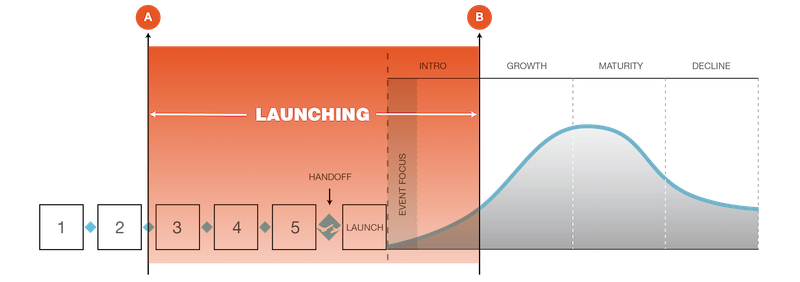
Congratulations for creating the world’s largest ball of twine, to be introduced to the world at TwineFest in August. Your twine-gineers worked tirelessly for years to complete the colossal landmark (it’ll be seen from outer space, of course). Stakeholders will be beaming as you pass the ball (sorry) to the marketing team in JULY. On a roll for success (again, sorry)! Welllll…not so fast.

There’s a giant red flag, a sure sign that the initiative is headed for trouble: Short-term launch thinking.
It’s the last-first stage.
That short-term perspective is fueled by the conventional way launch is viewed. In a traditional stage-gate development process for medical devices and other B2B products, launch is the last stage — the last stage in development and the first stage in the product lifecycle. And it’s almost always seen as a marketing communications function alone.
While you’re dealing with complexity greater than a twine ball, this short-term launch mindset can lead to problems:
- A hand-off to marketing with a too-short readiness window to position, plan, brand, and align. A rocky start at the outset.
- Event-based thinking yielding lost momentum later in market.
- A launch-it-all mentality arising from the view that launching is solely a marketing communications effort.
- Launch projections that promise quick uptake without a longer view of adoption.

Traditional product development stage-gate process allows for only a short window for planning a product’s entry to the market, which can lead to lost opportunity.
But what is the ideal product launch timeframe?
Ideal launch timeframe: Start earlier. End later.
Launching medical devices and other B2B products should involve a cross-functional Launch Leadership Team, led by a “Launch Navigator” who manages a go-to-market process that dovetails with the development process early on. How early does the ideal product launch timeframe start? We say, as early as possible. In highly regulated industries that might be when the project moves from upstream to downstream — 9-12 months is a good estimate. An early start allows proper time to achieve alignment on strategy, narrative, branding, and planning. It gives you time to launch internally, validate with customers, build momentum and make adjustments, so you can hit the market with the right velocity.
Similarly, your launching endpoint should be later than you may think. Again, when? Certainly not just a couple months from your go-to-market date. You don’t want to lose valuable momentum when you’re just entering orbit. 12 months is a good milestone to plant your Point B, with a roadmap that aligns hard and soft KPIs to that date, and into the adoption curve.

Starting launch earlier—involving a cross-functional launch team—improves alignment on strategy, narrative, branding, planning, and can increase momentum into the adoption phase
You might be thinking, “If we did all our launches this way, then we wouldn’t be launching as much.” Or maybe, “We should be launching more.” Exactly. We say that you’ll launch or release depending upon how important the launch is to your core business and how complex it is to communicate.
Read more about launching and releasing:
